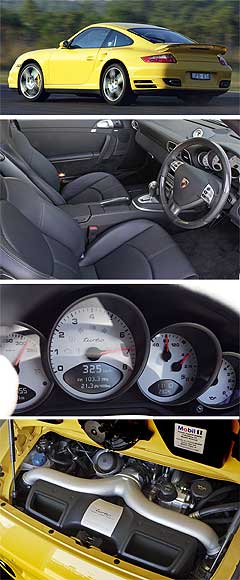Make / Model Search
New models - Porsche - 911 - TurboFirst drive: New 911 Turbo is auto eroticaAutomatic choice: The 997-series auto 911 Turbo is quicker than the manual. Porsche improves on automotive perfection with its ballistic new 911 Turbo18 Aug 2006 THE wait is finally over for the lucky, well-heeled few who've put down a cool $327,000 to own one of the automotive world's most awe-inspiring performance icons, the 911 Turbo. The first shipment of Porsche's redesigned 997-series 911 Turbo coupes has hit Aussie shores and by the time you read this all of the 80 examples bound for local roads this model year will have been spoken for. Unleashed on a gaggle of salivating Australian and, for the first time, American, Italian, German and Korean motoring scribes on derestricted roads in the Northern Territory over the past week, the all-new Turbo coupe has undoubtedly trumped its formidable predecessor, the first (996-series) 911 Turbo, which was widely regarded as the most complete supercar ever built. Trump card of the latest in a line of 911 Turbos that stretches back to 1974 is the world-first employment of variable-geometry turbo technology in a petrol engine. It's a feature that's been around in diesel engines since the 1990s, but Porsche is the first to overcome the white-hot (up to 1000 degrees C) exhaust gases it generates in petrol engines. The Zuffenhausen, Stuttgart-based sports car maker's solution was to add a water-cooling system to the existing oil-cooling system to prevent the meltdown of the turbo's adjustable rotor blades, which are made from aerospace-sourced materials - and to give the new Turbo even longer service intervals of no less than 30,000km or every two years. Up from 20,000km, the more infrequent service intervals reduce the overall service costs by more than 20 per cent, says Porsche. What's more, Porsche claims the cost of 911 Turbo ownership is further reduced by lower repair costs, and that it's the least expensive in its class to insure in its biggest-selling market, the US. But it's unlikely these issues will overshadow the bench-racing potential of the Turbo's Variable Turbine Geometry-equipped flat six, which employs a different (read: beefier) block to regular 911s but in the name of fuel economy still shares the entry-level 911's 3.6-litre displacement to deliver 353kW - or a staggering 98.1kW per litre. That's up from the 996's 309kW power peak and a specific output of 85.8kW/litre.  Even more impressive, however, is the new 911T's flexibility. Producing more torque at lower revs over a wider engine speed range, the 997 Turbo offers a muscular 620Nm between just 1950 and 5000rpm. The 996 offered "just" 560Nm between 2700 and 4600rpm. Even more impressive, however, is the new 911T's flexibility. Producing more torque at lower revs over a wider engine speed range, the 997 Turbo offers a muscular 620Nm between just 1950 and 5000rpm. The 996 offered "just" 560Nm between 2700 and 4600rpm.While those figures aren't as stratospheric as what's offered by rivals such as the Mercedes-Benz SL55 AMG (380kW/720Nm) and Ferrari F430 (360kW/465Nm), Porsche's says the new force-fed boxer engine's superior tractability - and new-generation all-wheel drive system - makes it more effective. Proof of this, it says, is a Nurburgring time of 7:49 in the hands of Walter Rohrl. The real-world result, in a (Getrag-supplied) six-speed manual version with the same aerodynamic slipperiness as its predecessor (0.31Cd) is 0-100km/h acceleration in a face-distorting 3.9 seconds - three-tenths quicker than the previous Turbo's benchmark. The five-speed Tiptronic S auto ($335,000), for the first time, is even quicker with a 0-100km/h dash time of 3.7 seconds. But that's not all. Fitted with the optional Sports Chrono Package, which gives 911 Turbo a "Sport" button for the first time, the huffed 997 lifts midrange torque delivery by 60Nm to 680Nm (via increased 1.2-bar boost pressure for up to 10 seconds at a time) and in fifth gear propels the 1585kg (auto: 1620kg) coupe from 80 to 120km/h in just 3.5 seconds. Without it, the 911T does it in 3.8 seconds - 1.2 seconds or 24 per cent faster than the 996 Turbo. Icing on the cake is lower fuel consumption and exhaust emissions, at a claimed 12.8 litres per 100km (auto: 13.6L/100km) on the EU composite cycle and 307 grams of CO2 per kilometre (327g/km) by the EU measurement standard respectively. Of course, that's in part due to an overall weight saving of 5kg on the old model - which comes largely from the use of an aluminium bonnet and doors but despite a 44mm-wider body overall and the standard fitment of VTG, wider 19-inch wheels, beefier brakes (42mm-larger 350mm vented front discs with six-piston callipers and 350mm rear discs with four-piston callipers), two extra side airbags (making a total of six), Porsche's Active Suspension Management (PASM), a tyre pressure monitoring system and an all-new multiplate clutch-based all-wheel drivetrain that dispenses with the previous 911T's viscous coupling and can direct maximum torque to either axle. All new models911 pricing
Motor industry news |
|

 Alfa Romeo
Alfa Romeo Abarth
Abarth Audi
Audi Aston Martin
Aston Martin BMW
BMW Bentley
Bentley Ferrari
Ferrari Chevrolet
Chevrolet Ford
Ford Fiat
Fiat GWM
GWM Foton
Foton Hyundai
Hyundai Honda
Honda Jaguar
Jaguar Isuzu
Isuzu Kia
Kia Jeep
Jeep Land Rover
Land Rover Lamborghini
Lamborghini Maserati
Maserati Lexus
Lexus McLaren
McLaren Mazda
Mazda Mercedes-Benz
Mercedes-Benz Mitsubishi
Mitsubishi Mini
Mini Peugeot
Peugeot Nissan
Nissan Ram
Ram Porsche
Porsche Rolls-Royce
Rolls-Royce Smart
Smart Skoda
Skoda Suzuki
Suzuki Subaru
Subaru Toyota
Toyota Tesla
Tesla Volvo
Volvo Zeekr
Zeekr







Facebook Twitter Instagram